We asked Anne Veck about trends in the global hairdressing industry over the next few years. This are her forecasts, including her vision of an AI, robotic salon experience! Do you agree?
1. Sustainability and eco-friendly practices. There has been a growing emphasis on sustainability within the hair & beauty industry, including the use of eco-friendly products and adopting practices that minimize environmental impact. Many salons and stylists are incorporating sustainable approaches into their businesses. At Anne Veck, we refitted both our salons to be more planet friendly between 2013 and 2018 and we have created a sustainable hairdressing tool kit “Salon RE:Source” (get it here bit.ly/SalonReSourceUK ) It has been downloaded over 1,600 times.
2. Wellness and self-care. Haircare is being viewed more holistically as part of overall wellness. Salons are offering services that promote relaxation and stress relief, tying into the broader trend of self-care. Hairdressers are caring people, they care for both their clients’ health and the health of the planet (see above).
3. Inclusivity and diversity. There’s a move towards more inclusive representations of beauty. This involves celebrating diverse hair textures, styles, and colours that reflect a broader range of cultural influences. It is now generally unacceptable to say “we don’t do your type of hair” and there is a growing demand from hairdressers to invest in training to fill this skills gap. To meet this demand, Anne Veck offers an “Introduction to Textured Hair” workshop, which she delivers in the UK and France.
Texture embrace. There’s a celebration of natural hair textures, with a move away from excessive heat styling. Embracing and enhancing the natural texture of hair has become a significant trend.
4. Natural and organic Products. There is an increasing demand for natural and organic haircare products, reflecting a broader consumer interest in clean beauty. This impacts the way we professionals approach haircare by incorporating more environmentally friendly options into our offerings. This demand is having a major effect on manufacturers who supply salons.
5. Radical new products. Multi-functional styling products are offering multiple benefits, such as volumizing, texturizing, and holding properties all in one, are gaining popularity. This is streamlining the styling process for professionals, allowing for versatility in creating different looks.
Colour-protecting Formulas. With the growing popularity of vibrant hair colours, colour-protecting shampoos, conditioners, and treatments are essential so that we can apply these products to maintain and enhance our clients’ colour treatments.
Dry Shampoos are gaining momentum, providing a quick solution for reviving hairstyles between washes and extending their longevity. Good for reducing water , energy and carbon emissions too.
6.Skill shortages and apprenticeship and training programmes. In the UK at least, initiatives to provide hands-on training and nurture new talent are confused and not communicated effectively. Apprenticeships (based in salons with a combination of practical skills and theory) are the favoured route into the industry by employers. However, the public (that is, parents and young people themselves), the education sector and politicians, favour higher education and thus the college route. Recent campaigning by industry bodies has resulted in the college based “T-level” (t =technical) for Hair and Beauty, having the hair component removed. There is now no T-Level for hairdressing . Whether or not this helps drive more young people into the apprenticeship route, remains to be seen.
7. Technology’s role. Technology has significantly transformed the hairdressing industry as follows: Online Booking: Simplifies scheduling through salon management apps and salon management software. Has been available for at least 10 years but uptake by salons has been slow. Unbelievably, in the UK some salons continue use paper based booking.
Social Media Impact: Influences trends and serves as a marketing tool, especially on platforms like Instagram & tiktok.
Virtual Consultations: Allows remote client consultations via video conferencing tools or salon-specific apps. This was popular during Covid and this has remained.
Salon management software and apps are enhancing business operations through platforms including client communication and loyalty. Digital payments ofcourse.
Smart Tools and Devices: Enhances styling precision and efficiency with smart hairdryers, straighteners, and colour mixers.
AI and robots. AI for personalization, tailoring services based on client preferences with AI-driven software. Plus other benefits such as virtual try-ons, enables clients to visualize hairstyles/colours through augmented reality features. And, yes, robots will replace human hairdressers for some simple functions and maybe completely. It’s already happening and if robots can carry out heart surgery then can definitely cut hair! There will always be a demand for the human touch but this may become a high end VIP luxury.
8. Industry collaboration. We are seeing early moves by manufacturers globally to address shared sustainability issues, mainly around carbon emissions and plastic. This work is usually carried out in a “pre-competitive space” and can involve all parties signing NDAs ( non disclosure agreements). So there is
(we hope) more happening than we are aware of. One great example is the Hairstyling Tools Collective, launched in London in October 2023. “A collaboration to lessen the environmental impact and increase the sustainability of hair tool products and to jointly support organizations, activities and endeavours that will help achieve these aims” .Hairstyling Tool Collective. — Hair industry sustainability (hairtoolcollective.com). Founded by Denman International and Olivia Garden, UK hairdressers Anne Veck and Melanie Tudor are their Sustainable Salon Champions and other manufacturers are invited to join.
So there you have Anne’s assessment of where the hairdressing industry is going. More sustainable, more diverse, more collaboration for the common good? Will a robot be cutting your hair in 5 years’ time?




